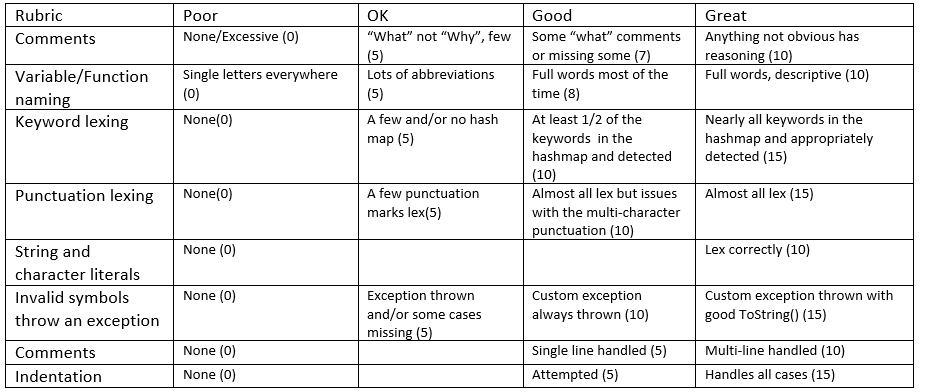Question
In this assignment, we will work toward completing our lexer. We will start by switching from just WORD to actual keywords. We will add the
In this assignment, we will work toward completing our lexer. We will start by switching from just "WORD" to actual keywords. We will add the punctuation that we need. We will process string and character literals ("hello" 'a'), deal with/ignore comments and finally, we will deal with indentation levels.
As you know, there are a lot of words in Shank that we must deal with. When we read (in English), we recognize words from the words that we have learned in the past. You might say that we associate a word with a concept or an idea. This association is a powerful concept and Java has support for it with HashMap.
A HashMap is a data structure that maps or associates two values. It can also be called a "key-value store". In the Hash Map, you can provide a key and get a value. This is perfect for looking up words. We want to, lookup a string ("while" for example) and get a token type (tokenType.WHILE).
HashMap
knownWords.put("while", tokenType.WHILE);
boolean doWeHaveWhile = knownWords.containsKey("while");
tokenType whileType = knownWords.get("while");
Look through the Language Description and build a list of keywords. Add a HashMap to your Lexer class and initialize all the keywords. Change your lexer so that it checks each string before making the WORD token and creates a token of the appropriate type if the work is a key word. When the exact type of a token is known (like "WHILE"), you should NOT fill in the value string, the type is enough. For tokens with no exact type (like "hello"), we still need to fill in the token's string. Finally, rename "WORD" to "IDENTIFIER".
Similarly, look through the Language Description for the list of punctuation. A hash map is not necessary or helpful for these - they need to be added to your state machine. Be particularly careful about the multi-character operators like := or >=. These require a little more complexity in your state machine. See the comment state machine example for an idea on how to implement this.
Strings and characters will require some additions to your state machine. Make "STRINGLITERAL" and "CHARACTERLITERAL" token types. These cannot cross line boundaries. Note that we aren't going to build in escaping like Java does ( " This is a double quote\" that is inside a string" or '\'').
Here is an example of what that state machine looks like; note that this is in addition to the existing state machine:
Comments, too, require a bit more complexity in your state machine. When a comment starts, you need to accept and ignore everything until the closing comment character. Assume that comments cannot be nested - {{this is invalid} and will be a syntax error later}. Remember, though, that comments can span lines, unlike numbers or words or symbols; no token should be output for comments.
A state machine example:
Your lexer should throw an exception if it encounters a character that it doesn't expect outside of a comment, string literal or character literal. Create a new exception type that includes a good error message and the token that failed. Ensure that the ToString method prints nicely. An example of this might be:
ThisIsAnIdentifier 123 ! {
Add "line number" to your Token class. Keep track of the current line number in your lexer and populate each Token's line number; this is straightforward because each call to lex() will be one line greater than the last one. The line number should be added to the exception, too, so that users can fix the exceptions.
Finally, indentation. This is not as bad as it seems. For each line, count from the beginning the number of spaces and tabs until you reach a non-space/tab. Each tab OR four spaces is an indentation level. If the indentation level is greater than the last line (keep track of this in the lexer), output one or more INDENT tokens. If the indentation level is less than the last line, output one or more DEDENT tokens (obviously you will need to make new token types). For example:
1 { indent level 0, output NUMBER 1 }
a { indent level 1, output an INDENT token, then IDENTIIFIER a }
b { indent level 2, output an INDENT token, then IDENTIFIER b }
c { indent level 4, output 2 INDENT tokens, then IDENTIFIER c }
2 { indent level 0; output 4 DEDENT tokens, then NUMBER 2 }
Be careful of the two exceptions:
If there are no non-space/tab characters on the line, don't output an INDENT or DEDENT and don't change the stored indentation level.
If we are in the middle of a multi-line comment, indentation is not considered.
Note that end of file, you must output DEDENTs to get back to level 0.
Requirements
Your exception must be called "SyntaxErrorException" and be in its own file. Unterminated strings or characters are invalid and should throw this exception, along with any invalid symbols.
Below is the lexer, shank and token files. The shank file is the main method file. There must be no error to the code at all. Run the whole code and show the output. Attached is the rubric.
Lexer.java
package mypack;
import java.util.ArrayList; import java.util.List;
public class Lexer { private static final int INTEGER_STATE = 1; private static final int DECIMAL_STATE = 2; private static final int IDENTIFIER_STATE = 3; private static final int ERROR_STATE = 4;
private static final char EOF = (char) -1;
private static String input; private static int index; private static char currentChar;
public List
while (currentChar != EOF) { switch (currentState()) { case INTEGER_STATE: integerState(tokens); break; case DECIMAL_STATE: decimalState(tokens); break; case IDENTIFIER_STATE: identifierState(tokens); break; case ERROR_STATE: throw new Exception("Invalid character: " + currentChar); default: break; } } return tokens; } private static int currentState() { if (Character.isDigit(currentChar)) { return INTEGER_STATE; } else if (Character.isLetter(currentChar)) { return IDENTIFIER_STATE; } else if (currentChar == '.') { return DECIMAL_STATE; } else { return ERROR_STATE; } } private static void integerState(List
Shank.java
package mypack;
import java.io.IOException; import java.nio.file.Files; import java.nio.file.Paths; import java.util.List;
public class Shank { public static void main(String[] args) { if (args.length != 1) { System.out.println("Error: Exactly one argument is required."); System.exit(0); }
String filename = args[0];
try { List
Lexer lexer = new Lexer();
for (String line : lines) { try { List
for (Token token : tokens) { System.out.println(token); } } catch (Exception e) { System.out.println("Exception: " + e.getMessage()); } } } catch (IOException e) { System.out.println("Error: Could not read file '" + filename + "'."); } } }
Token.java
package mypack;
public class Token { public enum TokenType { WORD, NUMBER, SYMBOL }
public TokenType tokenType; private String value; public Token(TokenType type, String val) { this.tokenType = type; this.value = val; } public TokenType getTokenType() { return this.tokenType; }

Step by Step Solution
There are 3 Steps involved in it
Step: 1

Get Instant Access to Expert-Tailored Solutions
See step-by-step solutions with expert insights and AI powered tools for academic success
Step: 2

Step: 3

Ace Your Homework with AI
Get the answers you need in no time with our AI-driven, step-by-step assistance
Get Started


